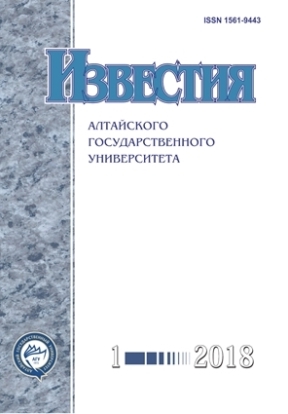Application of Principal Component Analysis to Investigation of Acoustic Emission Signals in Aluminum Alloys
Abstract
In this paper, an acoustic emission study of aluminum alloys subjected to static tension testing is conducted. Some of the test samples have welded joints in the test area. Influence of defects concentrated in a welded joint on acoustic emission signals is studied. The values of deformation stress and degree are used to construct the strain hardening curves and the acoustic emission count rate. Two areas of each strain hardening curve are analyzed. The first area corresponds to the stage of plastic yielding caused by uniform plastic deformation, while the second area corresponds to stages of discontinuous plastic deformation and fracture. The forms of acoustic emission count rates for solid and welded samples are significantly different due to highly defective structures in the welded joints.
Discrete wavelet transform coefficients are used as informative features of an acoustic emission signal. These coefficients are calculated for separate small intervals dividing the strain hardening curve. Principal component analysis (PCA) is utilized to process wavelet decomposition coefficients. The processing results are presented in the form of projections on first principal components planes. The calculations performed for the second area of each loading curve demonstrate that the acoustic emission signals of homogeneous samples and samples containing a welded joint are split into two linearly separated clusters. This indicates that proposed method provides an effective separation of signals produced in materials with different structures.
Obtained results can be used for acoustic-emission testing of deformation behavior and structure of products made with aluminum alloys.
DOI 10.14258/izvasu(2018)1-02
Downloads
Metrics
References
Chen C., Kovacevic R., Jandric D. Acoustic emission in monitoring quality of stir welweld in friction stir welding // 4th International Symposium on Friction Stir Welding. Utah (USA). — 2003.
Дмитриев А.А., Поляков В.В., Колубаев А.А. Диагностика алюминиевых сплавов со сварными соединениями на основе анализа сигналов акустической эмиссии // Фундаментальные проблемы современного материаловедения. — 2017. — Т. 14, №4.
Криштал М.М., Мерсон Д.Л. Взаимосвязь макролокализации деформации, прерывистой текучести и особенностей акустической эмиссии при деформировании алюминиево-магниевых сплавов // Физика металлов и металловедение. — 1996. — Т. 81, вып. 1.
Шибков А.А., Желтов М.А., Золотов А.Е., Денисов А.А. Акустическая эмиссия при распространении полосы Людерса в сплаве АМг6 // Вестник Тамбовского гос. ун-та. — 2010. — Т. 15, вып. 3.
Макаров С.В., Плотников В.А., Колубаев Е.А. Скачкообразная деформация и импульсная акустическая эмиссия при нагружении алюминиево-магниевых сплавов // Известия Алтайского гос. ун-та. — 2014. №1/2. DOI: 10.14258/izvasu(2014)1.2-36.
Esbensen K. H. Multivariate Data Analysis — In Practice. CAMO Process AS. — 2002.
Egorov A.V., Polyakov V.V. The Application of Principal-Component Analysis during Eddy-Current Testing of Aluminum Alloys // Russian Journal of Nondestructive Testing. — 2015. — Vol. 51.
Polyakov V.V., Egorov A.V., Lependin A.A. Modeling plastic deformation and fracture of porous materials // Technical Physics Letters. — 2005. — Vol. 31, N 2.
Mallat S. Wavelet Tour of Signal Processing. Academic Press. — 2009.
Marec A., Thomas J.-H., Guerjouma R. Damage characterization of polymer-based composite materials: multivariable analysis and wavelet transform for clustering acoustic emission data // Mechanical Systems and Signal Processing. — 2008. — Vol. 22.
Ferreira D.B.B., Da Silva R.R., Rebello J.M.A., Siqueira M.H.S. Failure mechanism characterisation in composite materials using spectral analysis and the wavelet transform of acoustic emission signals // Insight. — 2004. — Vol. 46.
Copyright (c) 2018 А.А. Дмитриев, В.В. Поляков, Д.Д. Рудер

This work is licensed under a Creative Commons Attribution 4.0 International License.
Izvestiya of Altai State University is a golden publisher, as we allow self-archiving, but most importantly we are fully transparent about your rights.
Authors may present and discuss their findings ahead of publication: at biological or scientific conferences, on preprint servers, in public databases, and in blogs, wikis, tweets, and other informal communication channels.
Izvestiya of Altai State University allows authors to deposit manuscripts (currently under review or those for intended submission to Izvestiya of Altai State University) in non-commercial, pre-print servers such as ArXiv.
Authors who publish with this journal agree to the following terms:
- Authors retain copyright and grant the journal right of first publication with the work simultaneously licensed under a Creative Commons Attribution License (CC BY 4.0) that allows others to share the work with an acknowledgement of the work's authorship and initial publication in this journal.
- Authors are able to enter into separate, additional contractual arrangements for the non-exclusive distribution of the journal's published version of the work (e.g., post it to an institutional repository or publish it in a book), with an acknowledgement of its initial publication in this journal.
- Authors are permitted and encouraged to post their work online (e.g., in institutional repositories or on their website) prior to and during the submission process, as it can lead to productive exchanges, as well as earlier and greater citation of published work (See The Effect of Open Access).








